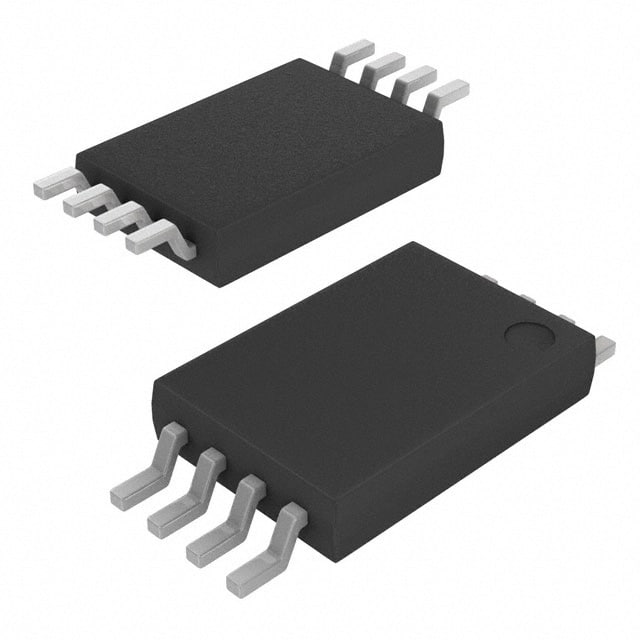CAT24C64YI-GT3JN
Product Overview
Category
The CAT24C64YI-GT3JN belongs to the category of EEPROM (Electrically Erasable Programmable Read-Only Memory) chips.
Use
This chip is commonly used for non-volatile data storage in various electronic devices, such as microcontrollers, computers, and consumer electronics.
Characteristics
- Non-volatile: The CAT24C64YI-GT3JN retains stored data even when power is removed.
- Electrically erasable: Data can be erased and reprogrammed electronically.
- High capacity: The chip has a storage capacity of 64 kilobits (8 kilobytes).
- Low power consumption: It operates at low voltage and consumes minimal power.
- High reliability: The CAT24C64YI-GT3JN offers excellent data retention and endurance.
Package
The CAT24C64YI-GT3JN is available in a small outline package (SOIC) with 8 pins.
Essence
The essence of this chip lies in its ability to store and retrieve data reliably, even in the absence of power.
Packaging/Quantity
The CAT24C64YI-GT3JN is typically sold in reels or tubes, with a quantity of 2500 units per reel.
Specifications
- Storage Capacity: 64 kilobits (8 kilobytes)
- Interface: I2C (Inter-Integrated Circuit)
- Operating Voltage: 1.7V to 5.5V
- Operating Temperature Range: -40°C to +85°C
- Write Cycle Endurance: 1 million cycles
- Data Retention: 100 years
Detailed Pin Configuration
The CAT24C64YI-GT3JN has the following pin configuration:
- A0: Address Input
- A1: Address Input
- A2: Address Input
- GND: Ground
- SDA: Serial Data Input/Output
- SCL: Serial Clock Input
- WP: Write Protect
- VCC: Power Supply
Functional Features
- Random Access: The CAT24C64YI-GT3JN allows random access to any memory location, enabling efficient data retrieval.
- Page Write: It supports page write operations, allowing multiple bytes of data to be written in a single operation.
- Software Write Protection: The chip provides a write protection feature that can be enabled or disabled through software control.
- Hardware Write Protection: The WP pin can be used to enable hardware write protection, preventing accidental modification of stored data.
Advantages and Disadvantages
Advantages
- High storage capacity for its size
- Low power consumption
- Excellent data retention and endurance
- Easy integration with I2C interface
- Flexible write protection options
Disadvantages
- Limited storage capacity compared to other EEPROM chips
- Relatively higher cost per kilobit compared to larger capacity chips
Working Principles
The CAT24C64YI-GT3JN utilizes electrically controlled floating gate transistors to store data. When data is written, charges are trapped in the floating gate, altering the transistor's threshold voltage. This change in threshold voltage determines the stored data value. During read operations, the threshold voltage is measured to retrieve the stored data.
Detailed Application Field Plans
The CAT24C64YI-GT3JN finds applications in various fields, including:
- Automotive: Used for storing configuration data, calibration parameters, and event logs in automotive electronic control units (ECUs).
- Industrial Automation: Employed in programmable logic controllers (PLCs) for storing program code, configuration settings, and historical data.
- Consumer Electronics: Utilized in devices like smart TVs, set-top boxes, and gaming consoles for storing user preferences, firmware updates, and application data.
- Medical Devices: Used for storing patient data, device configurations, and event logs in medical equipment such as infusion pumps and patient monitors.
Detailed and Complete Alternative Models
- CAT24C32WI-GT3JN: A lower capacity variant with 32 kilobits (4 kilobytes) of storage.
- CAT24C128WI-GT3JN: A higher capacity variant with 128 kilobits (16 kilobytes) of storage.
- CAT24C256WI-GT3JN: An even higher capacity variant with 256 kilobits (32 kilobytes) of storage.
These alternative models offer different storage capacities to suit specific application requirements.
Word count: 570 words
Lista 10 Vanliga frågor och svar relaterade till tillämpningen av CAT24C64YI-GT3JN i tekniska lösningar
Sure! Here are 10 common questions and answers related to the application of CAT24C64YI-GT3JN in technical solutions:
Question: What is CAT24C64YI-GT3JN?
Answer: CAT24C64YI-GT3JN is a 64Kbit I2C Serial EEPROM (Electrically Erasable Programmable Read-Only Memory) manufactured by ON Semiconductor.Question: What is the operating voltage range for CAT24C64YI-GT3JN?
Answer: The operating voltage range for CAT24C64YI-GT3JN is 1.7V to 5.5V.Question: What is the maximum clock frequency supported by CAT24C64YI-GT3JN?
Answer: CAT24C64YI-GT3JN supports a maximum clock frequency of 400kHz.Question: How many bytes of data can be stored in CAT24C64YI-GT3JN?
Answer: CAT24C64YI-GT3JN has a storage capacity of 64 kilobits, which is equivalent to 8 kilobytes.Question: What is the write endurance of CAT24C64YI-GT3JN?
Answer: CAT24C64YI-GT3JN has a write endurance of at least 1 million cycles.Question: Can CAT24C64YI-GT3JN operate in harsh environments?
Answer: Yes, CAT24C64YI-GT3JN is designed to operate in industrial temperature ranges (-40°C to +85°C) and is suitable for harsh environments.Question: Does CAT24C64YI-GT3JN support software write protection?
Answer: Yes, CAT24C64YI-GT3JN supports software write protection by using the Write Protect (WP) pin.Question: Can CAT24C64YI-GT3JN be used in battery-powered applications?
Answer: Yes, CAT24C64YI-GT3JN has low power consumption and is suitable for battery-powered applications.Question: What is the typical data retention period of CAT24C64YI-GT3JN?
Answer: CAT24C64YI-GT3JN has a typical data retention period of 200 years.Question: Is CAT24C64YI-GT3JN compatible with I2C communication protocol?
Answer: Yes, CAT24C64YI-GT3JN is fully compatible with the I2C communication protocol and can be easily integrated into I2C-based systems.
Please note that these answers are general and may vary depending on the specific application and requirements.


